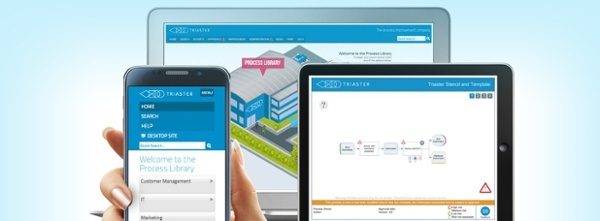If I asked you, 'what is business improvement?', you might reply with something simple like 'improving business performance'. This might include targeting ROI, cutting out business waste, or harnessing the latest tech innovations such as automation. You could throw around buzz words such as 'business transformation', 'continual improvement' or 'business intelligence' - but as business has changed, the definition of business improvement has also changed and the box of stuff you need (and don't need) to make those improvements happen has gotten a whole lot larger.
There are many business improvement techniques, methods, examples and external cultural influences out there today that have turned a relatively simple definition into something much, much harder to define.
What is Business Improvement?
Interestingly, when I Googled 'What is Business Improvement?', a large list of Business Process Improvement articles came up, but none that offered an explanation on what business improvement actually is.
That is largely based on the fact that today, when people think 'business improvement', they think 'business process improvement'
It may be a fait accompli that business improvement is thought to be dependent on process efficiency but is this the only factor that defines business improvement today? - obviously not.
The Evolution of Business Improvement Techniques

In order to find out what business improvement means today, we have to compare it against the techniques of the past.
Shigeo Shingo said that "the most dangerous kind of waste is the waste we do not recognize.” So too I think in order to harness business improvement correctly, we must understand its origins, how it changed, why it changed in order for you to identify the type of improvement initiatives that are adding zero value in your business
Approaches to business improvement have certainly changed over the years in respect to Four factors:
- Refining the Process
- Refining the Supply Chain
- Change in Consumer behaviour
- Innovation
Business Process Improvement -Refining the Process
For instance, the industrial revolution was one of the greatest turning points in modern business history. The moving assembly line was invented by Henry Ford in 1913 and was an example of taking a process, refining it and creating more product in less time with less cost to the manufacturer. The customer gets a cheaper product, the business makes more money - everyone wins.
Fast forward to today and the business process improvement model is a series of strings attached to other strings - no longer defined by its roots in manufacturing and agriculture. It has now expanded to include the software and service industries and has attached entirely distinct sub-cultures of thought such as improvement techniques and methodologies, and software systems dealing specifically with business process improvement through automation which quantifies current metrics in order to model future change.

If you want to improve the business, you need to capture all of the processes you currently carry out in the organisation. After they are captured in their current form, improvements can be modelled and change undertaken. These processes also need to be shared easily by staff so that they can easily find, use and refine the process further - this is how organisations successfully implement continual improvement in their organisations.
For more in-depth information on how to create and implement successful process mapping in your organisation,  .
.
Refining the Supply Chain
Business Improvement is not just defined by our in-house processes or systems anymore. To quote Brooks Hatlen from the film The Shawshank Redemption 'The world went and got itself in a big damn hurry'.
Improving the supply chain has become a big factor in business improvement and developing partnerships with other businesses that may be involved in varying degrees with your product implementation have opened up the world, allowed us to streamline the scope of our offerings to customers, while competition has allowed us to choose suppliers more shrewdly based on factors such as 'quality' that is as seminal to business practice today as it was superfluous to business practice 100 years ago.
Change in Consumer Behaviour
We live in a digital world. With social media giants such as Twitter, Facebook and LinkedIn offering customers a greater voice than ever before - and businesses are listening. The modern business has had to dust itself off, buy a brand new suit and tie and act like a grown-up. In a world where competition in business has become so fierce, consumer behaviour and concerns can no longer be ignored and as such, the definition of business improvement has been largely re-defined by targeting consumers and creating buyer personas so that the efficiency with which we are able to target potential buyers has become somehat of a science.
Quality has become one of the standout markers by which business improvement is now measured. A company with an ISO or EFQM Excellence certification is considered to be a safer bet for both customers and businesses to deal with - not to mention all important in advertising.
Businesses turn to quality because customers want it, customers want it because they were told by other companies with quality awards that they deserved it so those same companies could stand out from the crowd - and here we are today, with quality as a defining characteristic of business improvement.

Innovation
Business improvement used to mean innovation. When Ford created the moving assembly line it took time for others to catch up. Today, any thought you have can be recreated 20 different ways by lunch. Innovation is still important but it doesn't define business improvement anymore like it did in the past.
The Motivation for the Evolution of Business Improvement
The automotive industry was again responsible for one of the great re-defining moments in business improvement with lean production, which was initially developed at Toyota under the leadership of Taichi Ohno during the 1950s, and which introduced a revolutionary management process of product-development and production.
The first major shift involved new methods of manufacturing, the second major shift was in refining the production process to cut out waste.
Business improvement is clearly influenced by the desire to make more money, but it is also being more and more defined by the intent to save money. Here are three modern business focuses that fall under the banner of current 'motivations for business improvement':
- Saving money within the company and increasing ROI by making business processes more efficient and less expensive
- Saving money by increasing the efficiency of what goes on outside the business (making the supply chain and partnerships more efficient)
- Negating quality failure/risk/penalties by focusing on Quality Management and initiatives
- Customer considerations - focus groups, analysing new media, protecting corporate image and creating a perception of quality.
How Do We Apply and Measure Business Improvement Today?
There are many different business improvement software tools out there to help companies with their business improvement initiatives. Workflow Management, Business Process Management, Quality Management, Enterprise Resource Planning software to name just a few and even marketing CRMs are delivering the type of analytics, customer profiling and journey mapping that would not be out of place at a spy agency.
Improvement methodologies such as Kaizen, Lean and Six Sigma offer companies a new means of instilling business process improvement principles within their corporate culture to help implement Total Quality Management and Continuous Improvement.
It seems that the key to business improvement today is wading through crowded market places offering customers what they want, how they want it without seeming too pushy about it all while trying to work within budgets that aren't spent without vendor analysis, ROI analysis and customer analysis - business improvement involves a lot of analysis!
It's possible that you are more overwhelmed than when we started and that may be because while the world went and got itself in a 'big damn hurry', we humans are still individuals trying to catch up with the ever-shifting 'best practice' of business improvement that is defined by the many sub-categories it has developed along the way.
Business Process Improvement - The King of ROI
To help with any general confusion, we have more specific articles on business process improvement below under 'related articles' and if you're interested in recieving our blogs every week, you can sign up now and join our blog
If you liked this article, please use our social tabs on the page to share with others on social media.
Related Articles:
Business Improvement: Pros and Cons of a Process Approach
Establishing a Business Improvement Team: 4 Must Do Actions
Business Process Improvement: Stop Struggling, Start Doing
Business Process Improvement: Understanding the Impact of Change
Written by Brad Fagan
Brad joined Triaster in 2016 as our Content Marketing Executive hailing all the way from Middle Earth (the film version, not the book) – New Zealand. Brad’s video skills soon resulted in new weekly Triaster videos and his individual touch in some of the Connector and blog articles. In June 2018 Brad moved to Germany with his wife Lynn.
